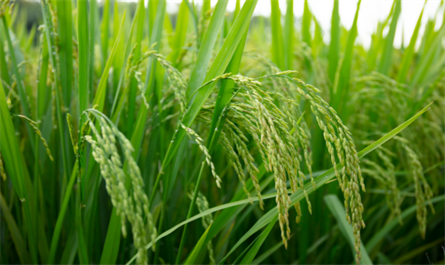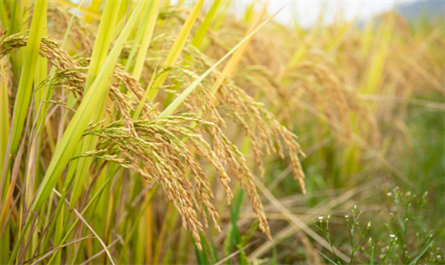10 plant growth regulators help regulate rice growth

1. Gibberellic Acid (GA3)
Gibberellic Acid (GA3) is a broad-spectrum plant growth regulator that can promote crop growth and development, make it mature early, increase yield, improve quality, and promote growth and increase yield through foliar spraying. Gibberellic acid can also quickly break the dormancy of seeds and promote germination. In the rice seed field, the first application of the drug is when the rice mother parent is 20-30% heading, and the second application is 1-2 days after the mother parent is 50-60% heading, which can increase the rice fruiting rate and increase yield.
Soaking rice seeds for 24 hours with 10-15 mg/L Gibberellic Acid solution can increase the germination rate of rice and make the germination uniform. It can also be used for the germination of regenerated rice. On the day of harvesting the first season rice, spray 20 mg/L with 50 L of water per acre. The second time, spray 20 mg/L with 50 L of water per acre when the heading rate is 20%.
2. Brassinolide
Brassinolide has high biological activity and diverse functions. It can not only promote the growth and fruiting of rice, but also improve the quality, increase the yield, enhance the stress resistance, promote seed germination, and reduce the damage caused by improper application of pesticides and fertilizers. Its application in rice production mainly includes the following aspects:
(1) Root promotion in the seedling stage. Brassinolide is used as seed treatment or spraying in the seedling bed stage to promote the growth of the root system of rice seedlings.
(2) Growth promotion in the vegetative stage. Brassinolide can promote cell division and cell elongation, increase the chlorophyll content of leaves, enhance photosynthesis, and can significantly promote the vegetative growth of rice and further increase the yield.
(3) Fruit promotion in the reproductive stage. Brassinolide can increase the germination rate of pollen, promote the elongation of pollen tubes, and facilitate flower fertilization, thereby increasing the fruit setting rate.
(4) Enhance stress resistance. After entering the plant body, Brassinolide can protect the membrane system of plant cells, stimulate the activity of protective enzymes in the plant body, and reduce damage caused by adversity, such as cold resistance, drought resistance, and pesticide resistance.
3. S-abscisic Acid (S-ABA)
S-abscisic Acid (S-ABA) is a plant growth balance factor and stress resistance induction factor. It has the ability to promote the balanced absorption of water and fertilizer by plants and coordinate metabolism in the body, activate the stress resistance immune system in the plant body, enhance the comprehensive resistance of rice (drought resistance, heat resistance, cold resistance, disease and insect resistance, salt and alkali resistance, etc.), and is beneficial to the growth and development of rice, and further improves its quality and yield.
Currently, it is mainly used for rice seed treatment, which has the functions of enhancing rice germination potential, improving germination rate, promoting root and seedling growth, promoting tillering and enhancing plant resistance. Using 0.3-0.4 mg/L and soaking seeds for 24-48 hours can promote germination.
4. Sodium Nitrophenolates (Atonik)
Sodium Nitrophenolates (Atonik) can quickly penetrate into the plant body after contact with plants, promote the flow of cell protoplasm, and improve cell vitality. Soaking seeds can promote seed germination and rooting, break dormancy, and can cultivate strong seedlings and improve the survival rate after repeated seedlings when sprayed on the seedbed. It can promote metabolism when sprayed on the leaves. Spraying during the flowering period can prevent flower drop, increase yield, improve quality and harvest early.
5. 1-Naphthyl Acetic Acid (NAA)
1-Naphthyl Acetic Acid (NAA) is a plant growth regulator that promotes plant root growth. It has the functions of promoting cell division and expansion, inducing the formation of adventitious roots, increasing fruit setting, preventing fruit drop, and changing the ratio of female and male flowers. Naphthaleneacetic acid has long been widely used in agricultural and forestry seedling cultivation, increasing fruit setting, and preventing fruit drop before harvest.

6. Choline chloride
Choline chloride is a broad-spectrum plant growth regulator that can increase the germination rate of crop seeds, promote rooting, form strong seedlings, and thus increase yield and improve quality.
7. Uniconazole
Uniconazole is a broad-spectrum, high-efficiency plant growth regulator with both bactericidal and herbicidal effects. It is a gibberellin synthesis inhibitor. Uniconazole has the effects of controlling vegetative growth, inhibiting cell elongation, shortening internodes, dwarfing plants, promoting lateral bud growth and flower bud formation, and enhancing stress resistance. It is suitable for rice, increasing tillering, controlling plant height, and improving lodging resistance. Use 50~200mg/kg for rice seeds. Use 50mg/kg for early rice, and 50~200mg/kg for single-season rice or continuous late rice depending on the variety. The ratio of seed volume to liquid volume is 1:1.2:1.5. Soak the seeds for 36 (24-28) hours, and mix the seeds once every 12 hours to facilitate uniform seed application. Then use a small amount to wash and germinate and sow. It can cultivate short and strong seedlings with multiple tillers.
8. Triacontanol
Triacontanol is a plant growth promoter with a wide range of applications. It is mainly extracted from beeswax, bran wax and cane wax. Triacontanol foliar spraying has an immediate effect on the promotion of chlorophyll content. After 4 minutes of treatment, the increase in reducing sugar and free amino acid content can be observed in rice seedlings. It has a good yield-increasing effect on rice, with an increase of more than 10%.
9. Ethephon
Ethephon plays an important role in the growth and development of crops and participates in regulating multiple physiological processes of plants, such as breaking dormancy, promoting flowering, and promoting fruit ripening. Spraying rice seedlings with Ethephon can significantly increase the release of ethylene in rice seedlings, thereby dwarfing plants, promoting root development, and increasing tillering, avoiding plant lodging, cultivating short and strong seedlings, promoting yield, and improving rice quality. At the same time, soaking seeds with ethephon can alleviate the effects of oxidative damage and osmotic stress damage on rice root growth, promote root growth and development, and improve rice salt tolerance.
10. Paclobutrazol (Paclo)
Paclobutrazol (Paclo) is widely used in rice production. It can inhibit the synthesis of endogenous gibberellins in plants, reduce cell division and elongation, make cells in various parts of rice smaller, delay plant growth and aging, and increase the activity of indoleacetic acid oxidase in rice, thereby weakening the apical growth advantage of rice seedlings, increasing tillering, increasing the number of green leaves of seedlings, promoting root growth, and enhancing the resistance of seedlings to stress. Paclobutrazol can be absorbed by rice seeds, leaves, and roots, so it can be used for rice seed dressing to increase germination rate; spraying during the rice seedling stage is conducive to cultivating short and strong seedlings; spraying during the rice panicle differentiation period promotes dwarfing and lodging resistance of plants; it can also inhibit the growth of weeds in the seedling field and increase rice yield.



